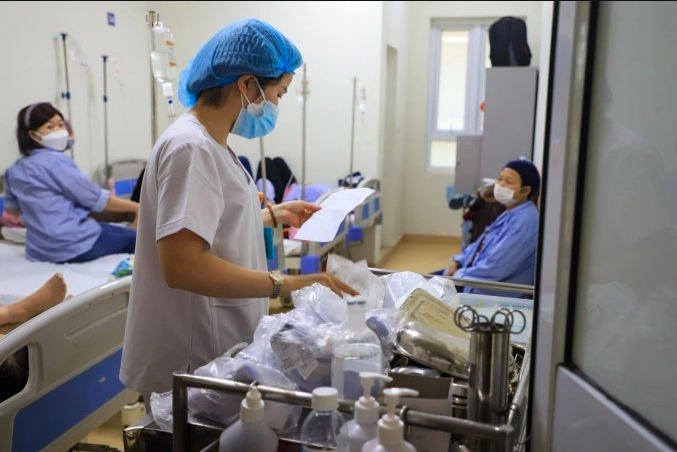These Ministry of Health-approved programs serve as a financial bridge, enabling patients to access expensive, newer medications while awaiting health insurance coverage. This reduces out-of-pocket expenses and allows them to maintain effective treatment plans.
Take, for example, Mr. He, a 70-year-old Hanoi resident with late-stage lung cancer. His cancer had metastasized to his abdominal lymph nodes, his overall condition was poor, he was ineligible for chemotherapy, and his prognosis was grim. Doctors at Hanoi Medical University Hospital recommended immunotherapy, involving a 3-week drug infusion cycle costing approximately 120 million VND.
"Immunotherapy is currently the most promising treatment for my condition, but the health insurance catalog doesn't cover all the newer drugs," Mr. He said. "If I pursue this treatment, I would need billions of VND to sustain it."
However, doctors informed him about Ministry of Health-approved assistance programs for cancer patients, including immunotherapy for lung cancer. After applying, he received a 50% subsidy for the immunotherapy, which improved his health and lessened the financial burden.
Associate Professor Trinh Le Huy, Deputy Director of the Oncology Center at Hanoi Medical University Hospital, noted that Mr. He responded well to the subsidized medication. Initially given only a few months to live, he has now undergone multiple treatment cycles and survived for over 3 years.
According to the Department of Health Insurance (Ministry of Health), these programs supported 10,652 patients between 2019 and 2024, primarily those with cancer, blood disorders, psoriasis, arthritis, and retinal diseases. Co-payment is the most common form of assistance, reducing financial pressure and preventing patients from abandoning their treatment. For instance, targeted therapy for cancer patients costs approximately one billion VND annually. With the program, patients only pay 30-40%, with the subsidy increasing over time. "From the 25th month onwards, patients pay only one-fourth of the drug cost, effectively receiving three free vials for every one purchased," explained Associate Professor Huy.
Dr. Nguyen Duc Hanh, Head of Oncology Department 2 at the Central Lung Hospital, also emphasized the programs' crucial supplementary role, especially since many new drugs aren't covered by health insurance. At the Lung Hospital, over 200 patients receive support for targeted and immunotherapy drugs. For example, a lung cancer patient using targeted therapy costing 82 million VND per month receives over a 50% discount through the program.
Beyond financial relief, these programs offer hope. "Previously, lung cancer treatment involved only conventional chemotherapy, with limited effectiveness. Now, immunotherapy can extend patients' lives by several years," said Associate Professor Huy.
 |
A nurse dispenses medication to an inpatient cancer patient at K Hospital. Photo: Quang Hung |
A nurse dispenses medication to an inpatient cancer patient at K Hospital. Photo: Quang Hung
Drug assistance programs are a common solution globally. In high-income countries, they aim to increase drug accessibility. In middle-income countries like Vietnam, they shorten the time to access new medications and expand treatment options. Medical experts consider these programs a supplementary financial tool, leveraging social resources, reducing pressure on the public health system, and contributing to the national goal of lowering out-of-pocket health expenses to below 30% by 2030, as outlined in Resolution 20/2017. In Mr. He's case, drug assistance prevented him from interrupting his treatment, giving him a renewed chance at life.
Le Nga












